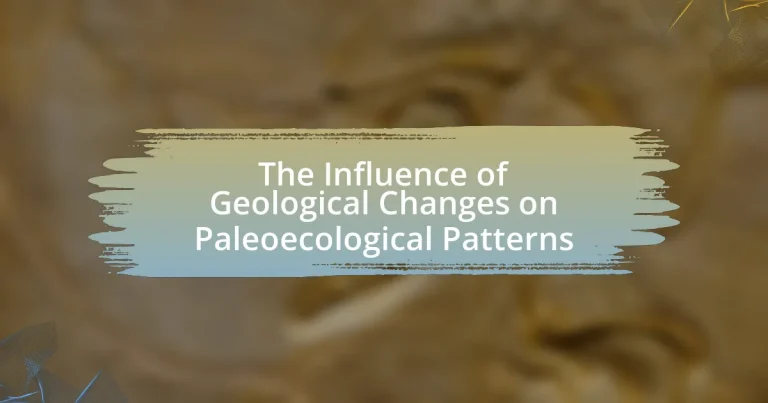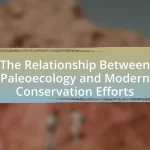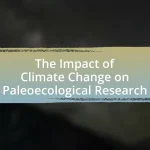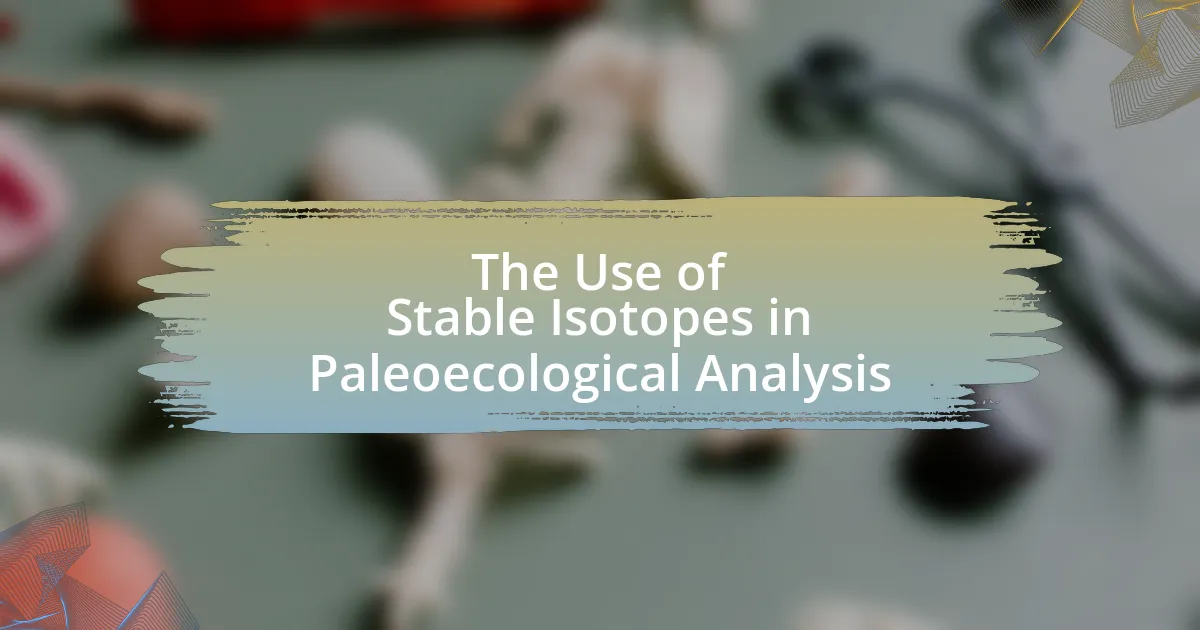The article examines the influence of geological changes on paleoecological patterns, highlighting how alterations in the Earth’s structure and composition, such as tectonic movements, volcanic activity, erosion, and sedimentation, shape ecosystems and biodiversity over time. It discusses the processes through which geological changes occur, their significance in understanding Earth’s history, and their impact on species distribution and adaptation. Additionally, the article explores the implications of these changes for modern ecosystems and conservation practices, emphasizing the importance of studying past geological events to inform current ecological strategies. Key methods for analyzing paleoecological patterns, including sediment and fossil analysis, are also outlined, providing insights into the historical relationships between organisms and their environments.

What are Geological Changes and Their Significance?
Geological changes refer to the alterations in the Earth’s structure and composition over time, including processes such as erosion, sedimentation, volcanic activity, and tectonic movements. These changes significantly impact ecosystems, influencing biodiversity, habitat availability, and the distribution of species. For instance, the uplift of mountain ranges can create new habitats, while volcanic eruptions can lead to the formation of new land and alter existing ecosystems. Geological changes also play a crucial role in shaping climate patterns, which further affects paleoecological dynamics by determining the types of flora and fauna that can thrive in specific regions.
How do geological changes occur over time?
Geological changes occur over time primarily through processes such as plate tectonics, erosion, sedimentation, and volcanic activity. Plate tectonics involves the movement of Earth’s lithospheric plates, which can lead to the formation of mountains, earthquakes, and oceanic trenches. For example, the Himalayas were formed as a result of the collision between the Indian and Eurasian plates approximately 50 million years ago. Erosion and sedimentation reshape landscapes by transporting materials from one location to another, influencing soil formation and habitat availability. Volcanic activity contributes to geological changes by creating new landforms and altering ecosystems, as seen in the formation of the Hawaiian Islands over millions of years due to hotspot volcanism. These processes are interconnected and contribute to the dynamic nature of Earth’s geology, impacting paleoecological patterns by influencing climate, habitat diversity, and species distribution over geological time scales.
What are the primary types of geological changes?
The primary types of geological changes are tectonic, volcanic, erosion, sedimentation, and metamorphism. Tectonic changes involve the movement of Earth’s plates, leading to earthquakes and mountain formation. Volcanic changes occur when magma erupts from the Earth’s interior, creating new landforms and altering landscapes. Erosion involves the wearing away of rocks and soil by wind, water, or ice, reshaping the Earth’s surface over time. Sedimentation is the process where particles settle out of a fluid, forming sedimentary rocks and altering geological structures. Metamorphism refers to the transformation of existing rocks due to heat, pressure, or chemically active fluids, resulting in new rock types. Each of these processes plays a crucial role in shaping the Earth’s geology and influencing paleoecological patterns.
How do tectonic movements influence geological changes?
Tectonic movements significantly influence geological changes by altering the Earth’s crust through processes such as plate tectonics, which can lead to the formation of mountains, earthquakes, and volcanic activity. These movements result from the shifting of tectonic plates, which can create new landforms and modify existing ones. For instance, the collision of the Indian and Eurasian plates has formed the Himalayas, demonstrating how tectonic activity can reshape landscapes over millions of years. Additionally, tectonic movements can trigger seismic events that reshape the geological structure of an area, as seen in the San Andreas Fault in California, where the lateral movement of plates has caused significant geological transformations.
Why are geological changes important for understanding Earth’s history?
Geological changes are crucial for understanding Earth’s history because they provide insights into the planet’s past environments, climate shifts, and biological evolution. These changes, such as plate tectonics, volcanic activity, and erosion, shape the landscape and influence the distribution of ecosystems over time. For instance, the breakup of the supercontinent Pangaea around 175 million years ago led to significant shifts in climate and biodiversity, resulting in the evolution of distinct flora and fauna in isolated regions. This historical context allows scientists to reconstruct past climates and ecological patterns, thereby enhancing our comprehension of how life on Earth has adapted to changing conditions.
What role do geological changes play in shaping ecosystems?
Geological changes play a crucial role in shaping ecosystems by altering habitats, influencing species distribution, and driving evolutionary processes. For instance, tectonic activities can create mountains, valleys, and new landforms, which in turn affect climate patterns and water availability. These changes can lead to the isolation of populations, promoting speciation as seen in the Galápagos Islands, where geological formations have contributed to the development of unique species. Additionally, events such as volcanic eruptions and glaciation can drastically modify landscapes, leading to shifts in biodiversity and ecosystem dynamics, as evidenced by the recovery of ecosystems following the last Ice Age, which reshaped flora and fauna across North America and Europe.
How do geological changes affect climate patterns?
Geological changes significantly affect climate patterns by altering the Earth’s surface and influencing atmospheric conditions. For instance, the uplift of mountain ranges can disrupt prevailing wind patterns, leading to changes in precipitation distribution. The formation of the Himalayas approximately 50 million years ago is a prime example, as it altered monsoon patterns across Asia, impacting regional climates. Additionally, volcanic activity can inject aerosols into the atmosphere, which can temporarily cool the climate by reflecting sunlight. The eruption of Mount Pinatubo in 1991 resulted in a global temperature drop of about 0.5 degrees Celsius for several years due to such aerosol emissions. These geological processes demonstrate a direct link between Earth’s physical changes and climate variability.
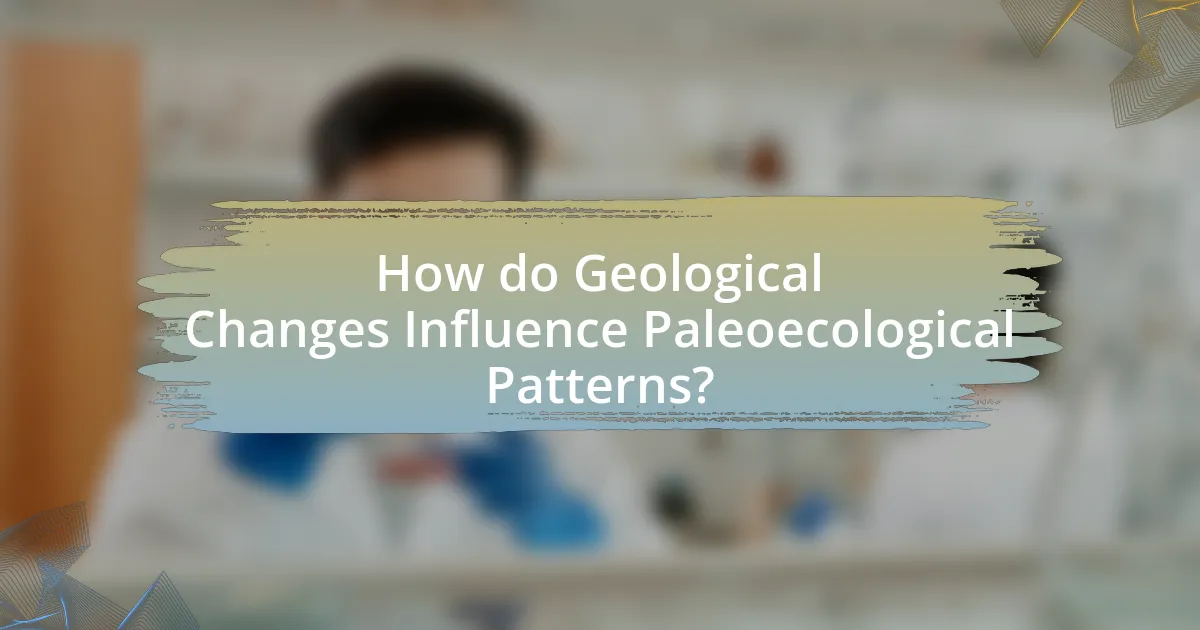
How do Geological Changes Influence Paleoecological Patterns?
Geological changes significantly influence paleoecological patterns by altering habitats, climate, and the distribution of species over time. For instance, tectonic shifts can create new landforms, such as mountains or valleys, which in turn affect local climates and ecosystems. The uplift of the Himalayas approximately 50 million years ago led to changes in monsoon patterns, impacting vegetation and animal life in the region. Additionally, volcanic activity can result in the formation of new islands, providing unique environments for species evolution. Fossil records indicate that mass extinctions, often linked to geological events like asteroid impacts or volcanic eruptions, drastically reshape biodiversity and ecological interactions. These geological processes are crucial in understanding the historical distribution and adaptation of species, as evidenced by the fossilized remains found in sedimentary layers that reflect past environmental conditions.
What are paleoecological patterns and why are they studied?
Paleoecological patterns are the historical distributions and relationships of organisms and their environments over geological time. These patterns are studied to understand how ecosystems respond to changes in climate, geography, and biotic interactions, providing insights into past biodiversity and ecosystem dynamics. Research indicates that analyzing fossil records and sedimentary data reveals how species adapted or went extinct in response to environmental shifts, such as the end-Permian mass extinction, which eliminated approximately 90% of marine species. Understanding these patterns helps scientists predict future ecological responses to ongoing climate change and habitat alteration.
How do fossil records contribute to our understanding of paleoecology?
Fossil records significantly enhance our understanding of paleoecology by providing direct evidence of past life forms and their environments. These records reveal the diversity of species, their morphological characteristics, and their distribution across different geological periods, which helps reconstruct ancient ecosystems. For instance, the presence of specific fossilized plants and animals indicates the climate and habitat conditions of the time, allowing scientists to infer ecological interactions and evolutionary processes. Additionally, fossil records can show how species responded to past geological changes, such as climate shifts or tectonic movements, thereby illustrating the dynamics of ecosystems over time. This information is crucial for understanding the resilience and adaptability of life in response to environmental changes.
What methods are used to analyze paleoecological patterns?
Methods used to analyze paleoecological patterns include sediment analysis, fossil analysis, and isotopic analysis. Sediment analysis involves examining sediment cores to identify changes in depositional environments over time, which can indicate shifts in climate and ecosystem dynamics. Fossil analysis focuses on the identification and quantification of fossilized remains, providing insights into past biodiversity and species interactions. Isotopic analysis, particularly of carbon and oxygen isotopes, helps reconstruct past environmental conditions and biological processes. These methods collectively enable researchers to interpret historical ecological changes in response to geological events.
In what ways do geological changes impact species distribution?
Geological changes impact species distribution primarily through habitat alteration, which can lead to shifts in available resources and environmental conditions. For instance, tectonic activities such as mountain formation can create barriers that isolate populations, leading to speciation, while volcanic eruptions can destroy habitats and force species to migrate. Additionally, changes in sea levels due to glacial cycles can expand or contract coastal habitats, affecting marine and terrestrial species alike. Historical evidence shows that during the Pleistocene epoch, glacial advances and retreats significantly influenced the distribution of species across North America and Europe, leading to the extinction of some species and the migration of others into newly available habitats.
How do geological events lead to extinction or diversification of species?
Geological events lead to extinction or diversification of species primarily through habitat alteration and environmental change. For instance, volcanic eruptions can create new landforms and alter climate conditions, which may result in the extinction of species unable to adapt to the new environment. The Permian-Triassic extinction event, approximately 252 million years ago, exemplifies this, as it is believed to have wiped out around 96% of marine species due to massive volcanic activity and subsequent climate shifts. Conversely, geological events such as continental drift can lead to diversification by creating isolated environments, allowing species to evolve independently. The formation of the Himalayas, for example, contributed to the diversification of species in the region by creating distinct ecological niches. Thus, geological events significantly influence species survival and evolution through both extinction and diversification mechanisms.
What examples illustrate the relationship between geological changes and species adaptation?
Geological changes significantly influence species adaptation, as evidenced by the evolution of the Galápagos finches. These birds adapted their beak shapes in response to varying food sources resulting from volcanic activity and climatic shifts on the islands. Research by Peter and Rosemary Grant demonstrated that during droughts, finches with larger beaks were more successful in accessing seeds, illustrating natural selection driven by geological and environmental changes. Another example is the diversification of mammals after the Cretaceous-Paleogene extinction event, where the rise of new habitats and the disappearance of dinosaurs allowed mammals to adapt and evolve into various forms, leading to the emergence of modern species. These instances underscore the direct correlation between geological transformations and the adaptive responses of species.

What are the Implications of Geological Changes on Modern Ecosystems?
Geological changes significantly impact modern ecosystems by altering habitats, influencing species distribution, and affecting biodiversity. For instance, tectonic shifts can create new landforms, such as mountains and valleys, which can lead to changes in climate and weather patterns, subsequently affecting the flora and fauna that inhabit those areas. Additionally, volcanic eruptions can introduce new minerals into the soil, enhancing fertility but also potentially leading to habitat destruction. Historical data shows that mass extinction events, often linked to geological changes, have drastically reshaped ecosystems, as seen during the Permian-Triassic extinction, where approximately 90% of species were lost. This illustrates that geological changes can have profound and lasting effects on the structure and function of modern ecosystems.
How can understanding past geological changes inform current ecological practices?
Understanding past geological changes can inform current ecological practices by revealing how ecosystems have historically responded to environmental shifts, thus guiding contemporary conservation efforts. For instance, the study of sediment cores from ancient lakes shows how species composition and biodiversity fluctuated in response to climate changes over millennia. This historical data allows ecologists to predict potential responses of current ecosystems to ongoing climate change, enabling the development of adaptive management strategies. Additionally, knowledge of past geological events, such as volcanic eruptions or glacial movements, helps identify resilient species and ecosystems that can withstand similar future disturbances, thereby informing restoration and preservation practices.
What lessons can be learned from historical paleoecological patterns?
Historical paleoecological patterns reveal that ecosystems are highly responsive to geological changes, demonstrating resilience and adaptability. For instance, the transition from the Pleistocene to the Holocene epoch saw significant shifts in species distribution and community composition due to climate change and glacial retreat. This adaptability underscores the importance of understanding past ecological responses to inform current conservation strategies. Additionally, the fossil record indicates that biodiversity often rebounds after mass extinction events, suggesting that ecosystems can recover if given sufficient time and appropriate conditions. These insights emphasize the need for proactive management of biodiversity in the face of ongoing environmental changes.
How do geological changes influence biodiversity today?
Geological changes influence biodiversity today by altering habitats, climate, and the distribution of species. For instance, tectonic plate movements can create new landforms, such as mountains and valleys, which in turn affect local ecosystems and species adaptation. The uplift of the Himalayas, for example, has led to significant climatic changes in Asia, impacting biodiversity by creating diverse habitats that support various species. Additionally, volcanic activity can lead to the formation of new islands, such as the Galápagos Islands, which have unique species due to their isolation and distinct environments. These geological processes contribute to speciation and extinction events, shaping the biodiversity we observe today.
What are the best practices for studying the influence of geological changes on ecosystems?
The best practices for studying the influence of geological changes on ecosystems include integrating multidisciplinary approaches, utilizing long-term ecological monitoring, and employing advanced modeling techniques. Multidisciplinary approaches combine geology, ecology, and climate science to provide a comprehensive understanding of interactions between geological changes and ecosystems. Long-term ecological monitoring, such as the study conducted by the National Ecological Observatory Network, allows researchers to observe changes over time and assess the impacts of geological events on biodiversity and ecosystem functions. Advanced modeling techniques, including Geographic Information Systems (GIS) and ecological modeling software, enable scientists to simulate potential future scenarios based on geological changes, thereby predicting their effects on ecosystems. These practices collectively enhance the accuracy and reliability of research findings in understanding the complex relationships between geological changes and ecosystem dynamics.
How can researchers effectively monitor geological changes and their ecological impacts?
Researchers can effectively monitor geological changes and their ecological impacts by utilizing remote sensing technologies, geological surveys, and ecological modeling. Remote sensing allows for the collection of data on land surface changes, such as satellite imagery, which can reveal shifts in vegetation and land use over time. Geological surveys provide in-depth analysis of soil composition and structure, enabling researchers to understand the physical changes in the landscape. Ecological modeling integrates data from both remote sensing and geological surveys to predict how these geological changes affect ecosystems, including species distribution and habitat alterations. For instance, studies have shown that satellite data can track deforestation rates, which directly correlate with changes in local biodiversity, demonstrating the interconnectedness of geological changes and ecological impacts.
What tools and technologies are available for paleoecological research?
Paleoecological research utilizes various tools and technologies, including sediment core analysis, stable isotope analysis, and ancient DNA sequencing. Sediment core analysis allows researchers to extract and study layers of sediment that contain fossilized remains, providing insights into past environments and climate changes. Stable isotope analysis helps in understanding the dietary habits and migration patterns of ancient organisms by examining isotopic ratios in their remains. Ancient DNA sequencing enables the retrieval of genetic material from extinct species, offering a direct link to past biodiversity and ecological interactions. These methods collectively enhance the understanding of how geological changes have influenced paleoecological patterns over time.
